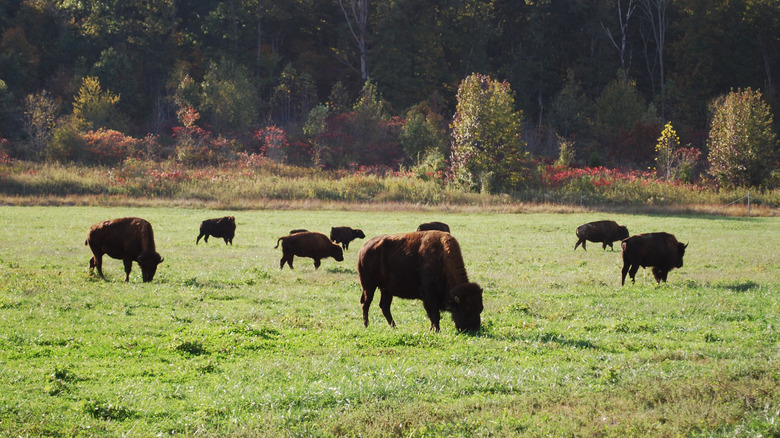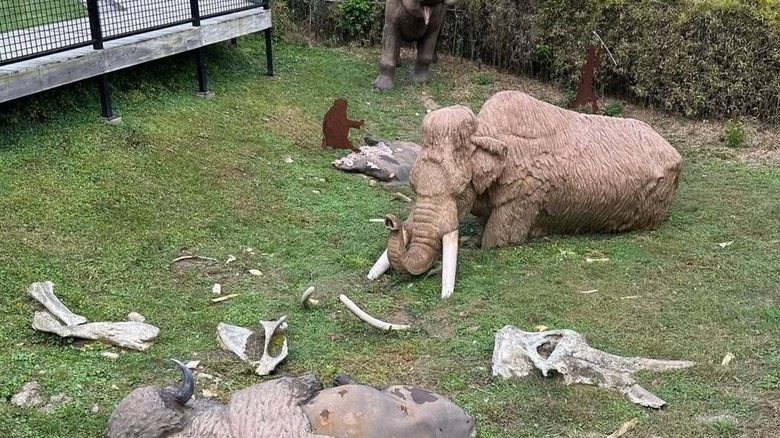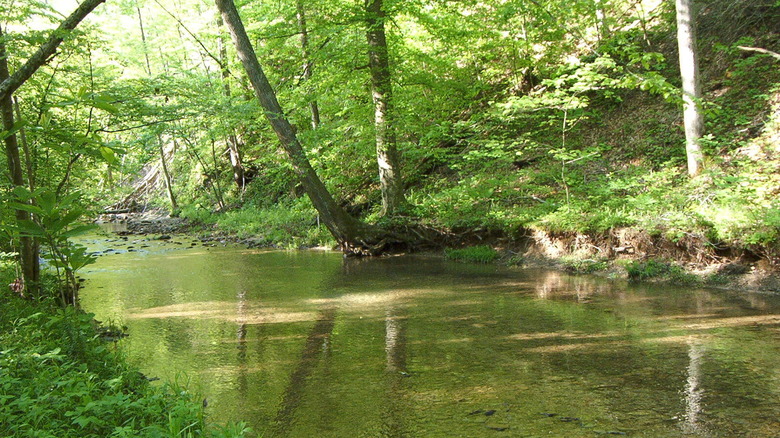Hike And Camp At One Of Kentucky's Most Unique State Parks With A Prehistoric Past
When it comes to historic American travel destinations, most people think of battlefields, colonial towns, and centuries-old landmarks. But history goes much deeper — thousands of years deeper — at Big Bone Lick State Historic Site. While you can certainly explore some colonial American history in Kentucky's oldest city, located in its stunning bluegrass region, this park tells a story that stretches back to the Ice Age. Here, prehistoric creatures once roamed, and the land still holds remnants of their past, from fossilized bones to ancient salt springs.
There are only a handful of places in the U.S. where you can experience prehistoric wonders in their original setting — think of the dinosaur footprint hiking trail in Massachusetts. Big Bone Lick stands out for its combination of Ice Age history and present-day ecological significance. The park features active mineral springs, a museum showcasing fossils, an outdoor diorama pit, and trails leading through historic excavation sites. Perhaps its most remarkable living link to the past is its bison herd, which continues the cycle of life that began here thousands of years ago.
Stroll among bones and bison
One of the living elements of Big Bone Lick — which is also a key to its past — is its bison herd. These animals are drawn to the area's natural salt lick, just as their ancestors were (bison are some of the only surviving descendants of Ice Age mammals). A salt lick is a natural mineral deposit that animals seek out for essential nutrients. For thousands of years, Ice Age creatures like mammoths, mastodons, and giant ground sloths made their way to these licks for sustenance. Many became trapped in the area's swampy terrain, leaving behind well-preserved fossils that would be uncovered thousands of years later.
Big Bone Lick is also significant as the site of an early American paleontological expedition. In 1807, President Thomas Jefferson sent William Clark — of the famed Lewis and Clark duo — to collect fossils from the area and ship them back east. Meriwether Lewis himself had visited earlier, but the bones he gathered were lost en route. Today, visitors can see fossils and life-sized replicas of these prehistoric giants at the park's must-see free museum. Next to the visitor center, the Megafauna diorama pit brings the past to life with detailed scenes and historical descriptions, giving a vivid picture of what Kentucky looked like during the Pleistocene era.
Trails, wildlife, and outdoor fun at Big Bone Lick
Big Bone Lick isn't just about prehistoric history — it's also a fantastic place for outdoor activities. The Discovery Trail is an easy half-mile walk that starts at the diorama pit and features informational panels about the area's past. For those looking to explore further, the park offers 4.5 miles of hiking trails. One of the longest, Big Bone Creek Trail, is a mile-long loop that winds through mineral springs, excavation sites, and the creek itself. If spotting the bison is on your list, your best bet is the Bison Trace Trail, which runs through their grazing pastures.
Beyond hiking, the park is a great spot for picnicking, birdwatching, and orienteering. The picnic grounds are well equipped with tables, grills, and playgrounds, making it a great place for families to spend the day. Bird enthusiasts can spot Ruby-throated Hummingbirds in the spring, hawks and owls in the summer, and a variety of migratory species year-round. Orienteering — a navigation sport using a map and compass — is also popular here, with two courses winding through the park's woodlands. Modern-day adventurers can lose themselves here in a landscape that once trapped mammoths.
Big Bone Lick State Park is easily accessible by car from Cincinnati, Ohio, with the Cincinnati/Northern Kentucky International Airport just a 30-minute drive away. Visitors can choose between staying in a hotel in the city — where they can explore some of the most spectacular street art in America — or fully immersing themselves in history by camping at one of the park's 62 campsites. Either way, Big Bone Lick is a journey into the past that's just a short drive from modern life.


